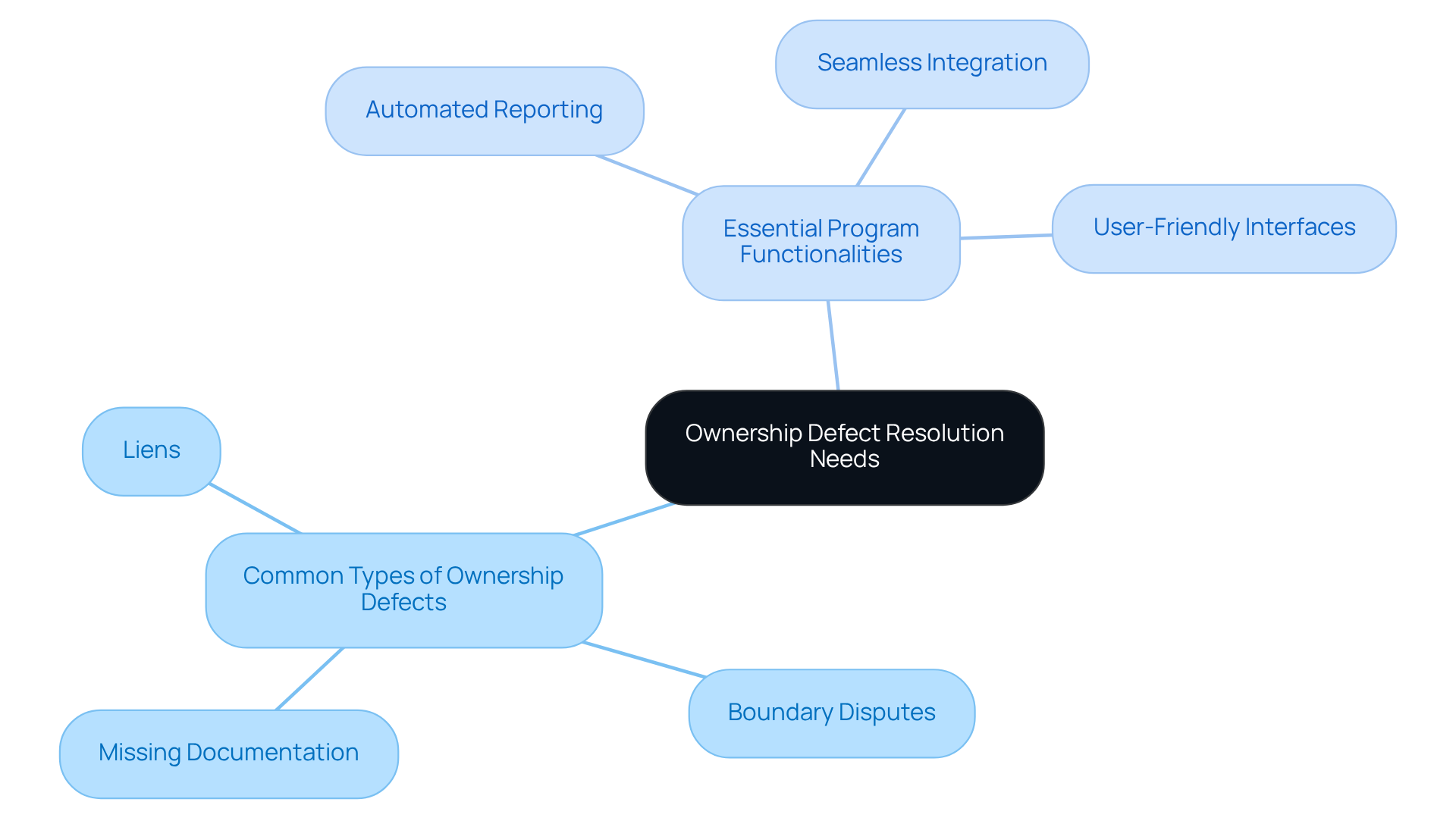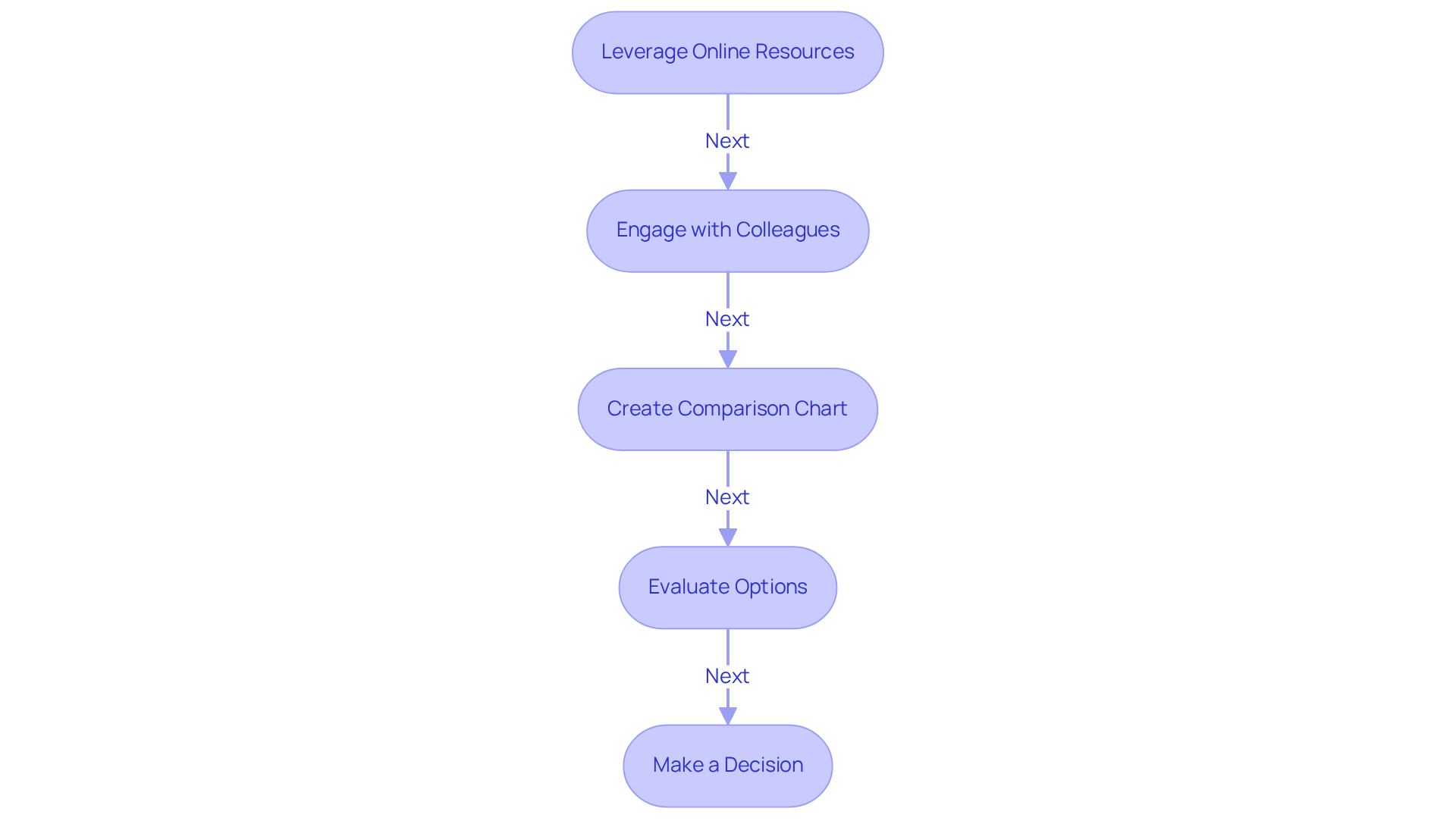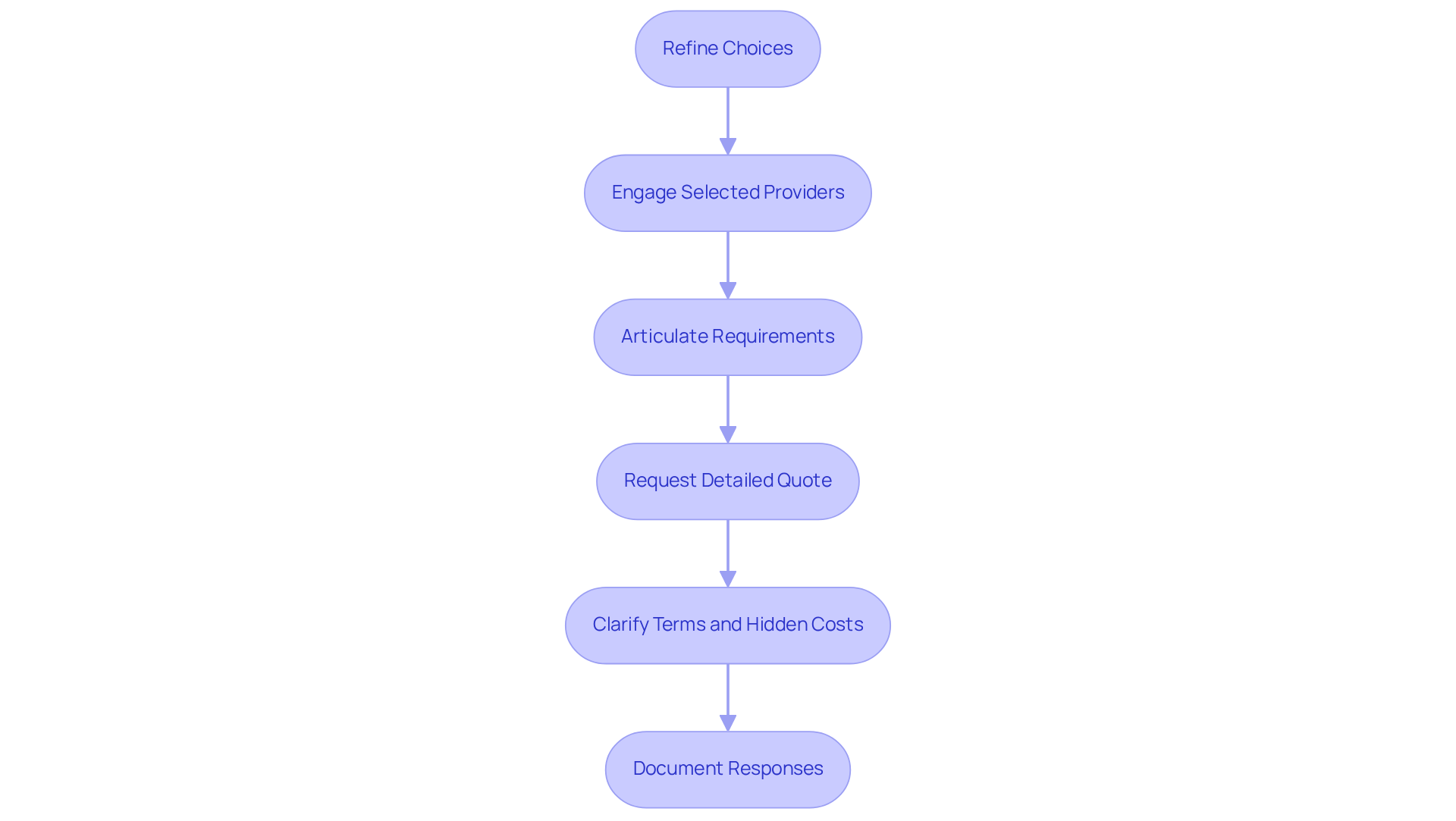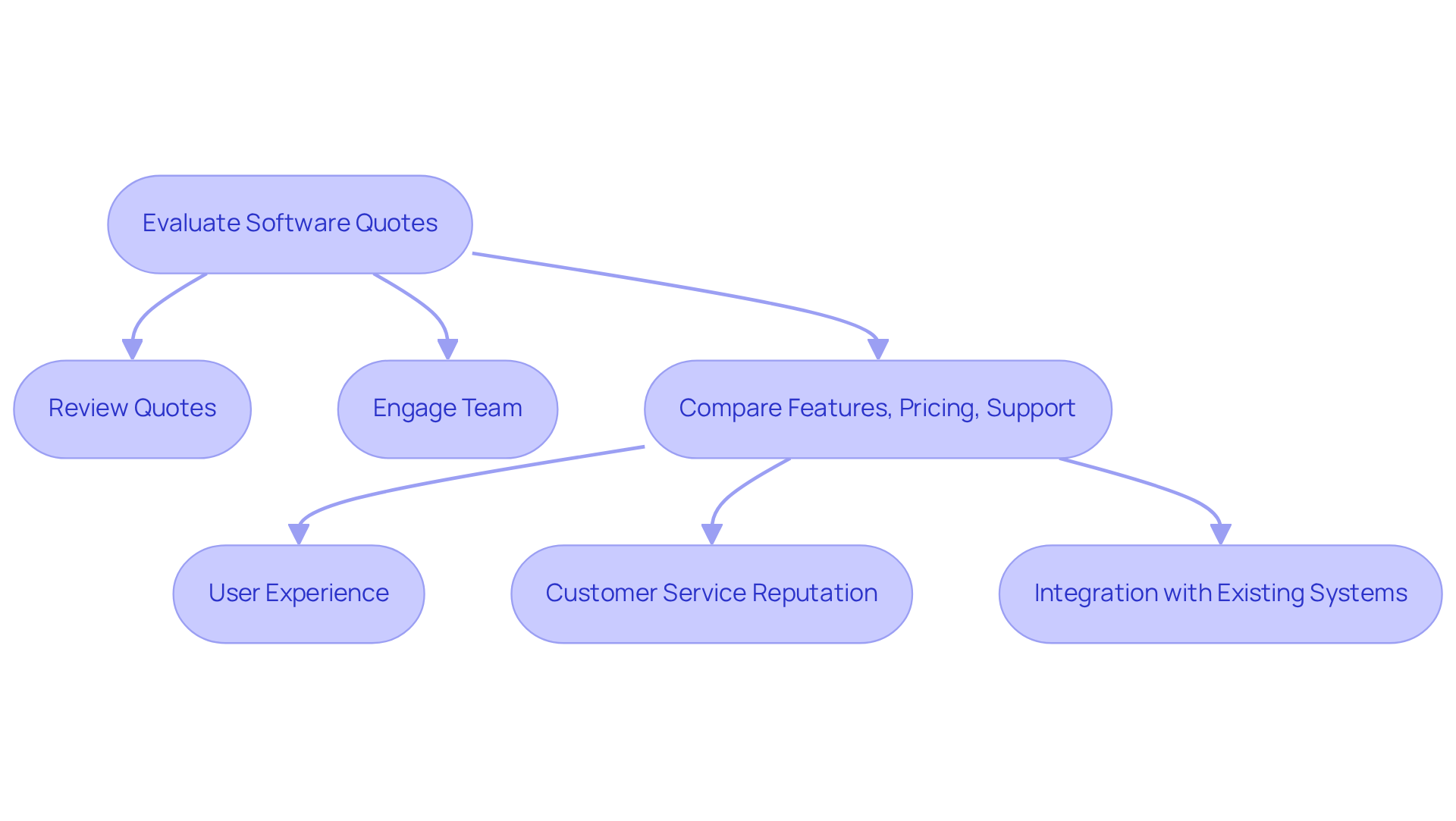Overview
The article delineates a four-step process for acquiring quotes for title defect resolution software:
- Identifying needs
- Researching software options
- Requesting quotes
- Evaluating them
This structured approach underscores the significance of accurate title research in real estate transactions. Furthermore, each step highlights the necessity of collaboration, thorough evaluation of features and costs, and leveraging peer insights. This ensures that the selected software effectively addresses ownership defects, ultimately enhancing the reliability of real estate transactions. By following this methodical process, stakeholders can navigate the complexities of title defect resolution with confidence.
Introduction
Navigating the complexities of title defect resolution can often feel like traversing a minefield, with various ownership issues lurking beneath the surface. As real estate transactions grow increasingly intricate, understanding how to effectively secure the right software solutions is paramount.
This guide reveals a structured approach to obtaining quotes for title defect resolution software, ensuring that organizations can streamline their processes and mitigate risks.
Furthermore, how can one discern the best options amidst a sea of choices, and what critical factors should be considered to make an informed decision?
Identify Your Title Defect Resolution Needs
To effectively address ownership defects, it is essential to start by identifying the common types encountered, such as liens, boundary disputes, and missing documentation. Notably, more than one-third of real estate dealings necessitate exceptional efforts to tackle ownership complications, underscoring the prevalence of these flaws.
Compile a detailed list of essential program functionalities, including:
- Automated reporting
- Seamless integration with existing systems
- User-friendly interfaces
As Rande Yeager, President of the American Land Association, states, "This clearly demonstrates the significance of a professional property search in ."
Interacting with your team is vital; collect their perspectives on challenges and expectations to ensure the chosen solution enhances overall effectiveness in addressing issues. This collaborative approach not only simplifies the resolution process but also aligns technological capabilities with the specific challenges encountered in your operations.

Research Available Title Defect Resolution Software
To effectively identify , it is essential to leverage online resources such as review platforms and industry forums to get quotes for title defect resolution software. These sources provide valuable user feedback and evaluations that assist in determining the effectiveness of various options. Furthermore, engaging with colleagues in the real estate industry can yield suggestions based on direct experiences, thereby enhancing your understanding of each tool's strengths and weaknesses. Notably, Parse AI collaborates with land service professionals to tackle challenges, underscoring the significance of peer insights in your selection process.
To streamline your evaluation, create a comprehensive comparison chart outlining key features, pricing structures, and customer support options. This organized approach will promote informed decision-making and ensure that you are able to get a quote for title defect resolution software that best suits your needs. As the Defect Management Tool Market is projected to reach USD 12.71 billion by 2032, the importance of selecting efficient applications cannot be overstated. According to Aarti Dhapte, the increasing demand for quality assurance in technology further emphasizes the necessity for thorough evaluation.

Request Quotes from Software Providers
After refining your choices, it is crucial to engage with the selected service providers to get a quote for title defect resolution software. Clearly articulate your specific requirements and request a detailed breakdown of costs, including any additional fees associated with setup, training, or ongoing support to get a quote for title defect resolution software. It is vital to clarify the terms of service and identify any potential hidden costs that may arise. Notably, the is approximately 2.7 times a developer’s base salary, providing context for pricing expectations. Documenting all responses will facilitate effective comparison later, enabling you to make an informed decision.
Laura Schomaker emphasizes the importance of understanding the key points vendors should include in an ERP quote, reinforcing the necessity for thoroughness in your inquiries. Furthermore, consider the insights from the case study on Parse AI, which demonstrates significant cost reductions compared to conventional title research techniques, highlighting the advantages of productive collaboration with service providers.

Evaluate and Compare Software Quotes
Carefully review each quote, comparing features, pricing, and support options. Utilize your comparison chart to underscore the of each application solution. Consider critical factors such as:
- User experience
- Customer service reputation
- The program's ability to integrate with your existing systems
Furthermore, engage your team in the evaluation process to gather diverse perspectives, ensuring that the selected software meets everyone's needs.

Conclusion
Identifying and resolving title defects is a crucial process in real estate transactions. Utilizing the right software significantly streamlines this task. By following the outlined steps—understanding your specific needs, researching available software, requesting quotes, and evaluating those quotes—you ensure that you select the most effective title defect resolution software for your organization.
This article underscores the importance of a systematic approach, beginning with a thorough analysis of the types of title defects encountered. Engaging with peers and utilizing online resources provides valuable insights into the best available solutions. Furthermore, documenting and comparing quotes from different software providers allows for a more informed decision, ensuring that the selected software not only meets functional requirements but also aligns with budgetary constraints.
Ultimately, investing time in this process leads to significant long-term benefits, including reduced costs and improved efficiency in handling title defects. By prioritizing a collaborative approach and leveraging the right tools, real estate professionals navigate ownership challenges more effectively, paving the way for smoother transactions and enhanced client satisfaction.
Frequently Asked Questions
What are the common types of ownership defects in real estate?
Common types of ownership defects include liens, boundary disputes, and missing documentation.
How prevalent are ownership complications in real estate dealings?
More than one-third of real estate dealings require exceptional efforts to tackle ownership complications.
What are some essential program functionalities needed to address title defect resolution?
Essential program functionalities include automated reporting, seamless integration with existing systems, and user-friendly interfaces.
Why is a professional property search important in real estate transactions?
A professional property search is important because it helps identify and resolve ownership defects, as emphasized by Rande Yeager, President of the American Land Association.
How can team interaction improve the resolution of ownership defects?
Interacting with your team allows for gathering perspectives on challenges and expectations, which ensures that the chosen solution enhances overall effectiveness in addressing issues.




